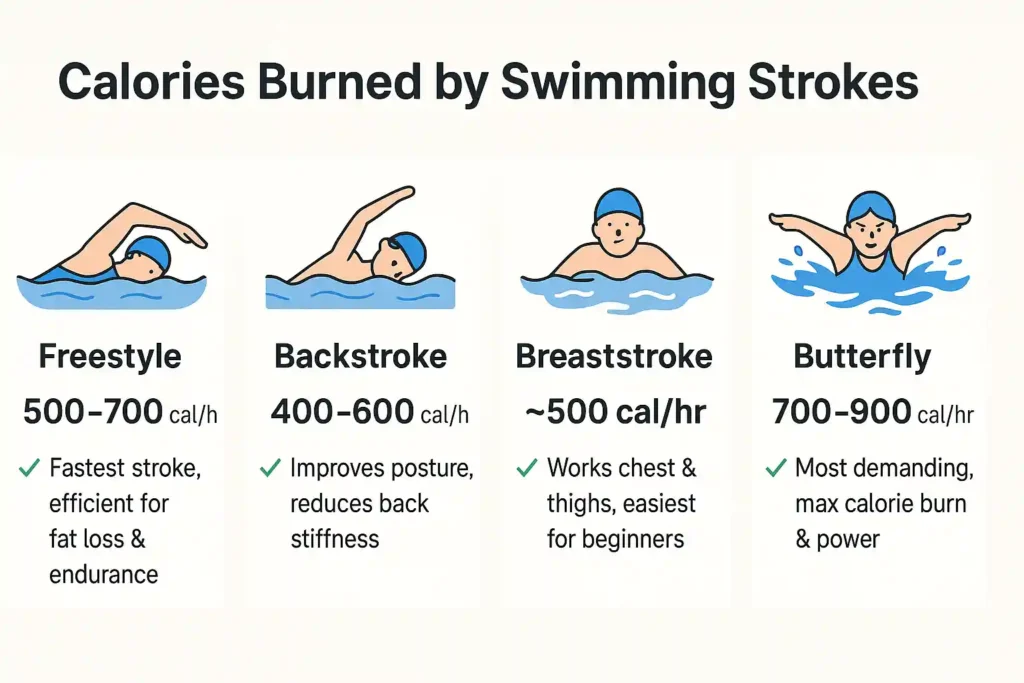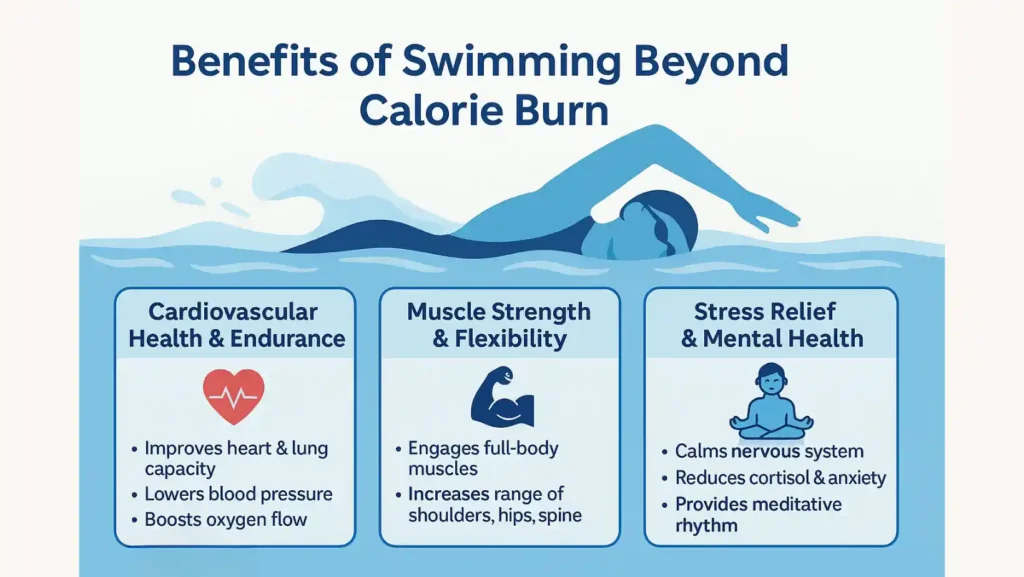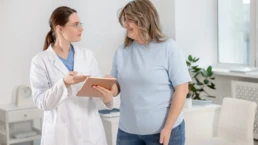Introduction to Swimming as a Calorie-Burning Exercise
How many calories does swimming burn? The answer surprises many people. Swimming is more than a leisure activity; it is a powerful workout that torches calories, strengthens muscles, and improves heart health.
Table of Contents
ToggleUnlike running or cycling on hard surfaces, swimming places your body in water, where every motion meets resistance. This constant resistance makes swimming one of the most energy-demanding exercises you can do, while still being easy on your joints.
Swimming also has a special advantage. It combines cardiovascular training with strength training in a single workout. While other workouts often focus on one aspect, swimming delivers a complete package that is hard to match.
Why Swimming is an Effective Full-Body Workout
Water is about 800 times denser than air. Every time you push your arm forward or kick your leg, your body works against this density. That is why swimming calories burned are higher than walking at the same pace. It is not only the arms or legs that work. Your shoulders, chest, back, and especially your core are constantly engaged to stabilize your body.
This is different from running, where only your legs do the majority of work, or cycling, where your lower body dominates. Swimming recruits both upper and lower body equally, which is why it is considered one of the best swimming fitness benefits for people who want efficiency in their workouts.
Swimming Exercise Calories vs. Other Cardio
When we talk about swimming exercise calories, the numbers are comparable to high-intensity cardio. A moderate freestyle session can equal a jog at 6 mph. However, swimming often burns slightly more because of the resistance of water.
Another point to remember is recovery. Runners often face joint pain after long distances, while swimmers recover faster due to the water’s cushioning effect.
That is why many athletes consider swimming as cardio an excellent replacement when they need to avoid stress on the knees or ankles.
Factors That Influence Swimming Calories Burned
Body Weight and Metabolism
The relationship between body weight and calorie burn is simple: heavier bodies displace more water and require more energy to move.
For instance, a 60-kg swimmer may burn 400 calories in one hour of freestyle, while a 90-kg swimmer may burn over 600 calories.
Metabolism adds another layer. A person with an active metabolism will continue burning calories at a higher rate even after leaving the pool. This afterburn effect, while smaller than weightlifting, is still significant in swimming.
Swimming Intensity and Duration
Intensity directly controls calories burned swimming. A gentle float or casual strokes will not raise your heart rate enough. High-intensity sprints, flip turns, and interval laps demand more oxygen and energy, leading to faster calorie use.
Duration matters equally. A 20-minute swim can boost mood, but a 60-minute structured workout can help burn as many calories as a long-distance run.
Pool Laps vs. Leisure Swimming
There is a difference between swimming structured laps and splashing for fun. Leisure swimming may burn around 250 calories per hour, while continuous lap swimming can double or triple that.
The structured nature of lap swimming, counting sets, timing rest periods, and pushing through resistance ensures that energy use remains steady.
Calories Burned by Different Swimming Strokes

Each stroke uses energy differently. The calorie range depends on speed, weight, and efficiency.
Freestyle Swimming (Front Crawl)
Freestyle swimming is the fastest stroke for most people. It burns between 500 to 700 calories per hour. Because of its efficiency, many beginners choose freestyle for fat loss and endurance training.
Backstroke Swimming
Backstroke swimming is more relaxed yet still effective. It burns 400 to 600 calories per hour. Its supine position helps improve posture and reduce back stiffness while still contributing to overall calorie burn.
Breaststroke Swimming
Breaststroke swimming is slower, but it works the inner thighs, chest, and arms. It burns around 500 calories per hour for an average-weight swimmer. It is also the easiest stroke to learn for beginners.
Butterfly Swimming
Butterfly swimming is the most energy-demanding stroke. It burns 700 to 900 calories per hour. Competitive swimmers often use butterfly to push cardiovascular limits and build explosive muscle power.
| Stroke | Calories Burned per Hour (70-kg person) | Muscles Targeted |
| Freestyle | 500–700 | Arms, shoulders, chest, core, legs |
| Backstroke | 400–600 | Back, shoulders, core, legs |
| Breaststroke | 450–550 | Chest, arms, thighs, glutes |
| Butterfly | 700–900 | Chest, shoulders, arms, core, back, legs |
Estimating Calories Burned Swimming Workouts
Swimming for 30 Minutes
In half an hour, calorie burn ranges from 200 to 450 depending on the stroke. For example, freestyle burns about 300, breaststroke burns 250, and butterfly can reach 450.
Swimming for 1 Hour
A one-hour structured workout easily crosses 600 calories, sometimes even 900. Advanced swimmers often add resistance equipment to push their burn further, making it closer to 1000 calories.
Using a Swimming Calories Calculator
A calories calculator swimming tool can give tailored numbers. Enter your weight, stroke, and time to estimate burn. While not exact, it helps track progress in long-term swimming endurance training plans.
Swimming vs. Other Exercises: Calorie Burn Comparison
| Exercise Type | Average Calories Burned per Hour (70 kg person) | Impact on Joints | Key Benefits |
| Freestyle Swimming | 500–700 | Low impact | Full-body workout, builds stamina, tones muscles |
| Backstroke Swimming | 400–600 | Low impact | Improves posture, strengthens back and shoulders |
| Breaststroke Swimming | 450–550 | Low impact | Engages thighs, chest, and glutes, easier for beginners |
| Butterfly Swimming | 700–900 | Moderate strain on shoulders | Maximum calorie burn, builds explosive strength |
| Running (6 mph) | ~700 | High impact on knees/ankles | Strong cardiovascular workout, improves bone density |
| Cycling (moderate) | 500–600 | Low to moderate impact | Strengthens lower body, good endurance builder |
| Weightlifting | 200–300 | Low impact | Builds muscle mass, increases metabolism after workout |
How to Maximize Calorie Burn While Swimming?
Interval Training in the Pool
Interval training alternates fast laps with slow recovery laps. For example, swim 2 laps freestyle at top speed, then 1 lap slowly. This boosts metabolism, improves stamina, and maximizes calorie burn.
Resistance Training and Swim Equipment
Paddles, fins, and drag suits make movements harder. Kickboards isolate leg work while paddles strengthen arms. These tools turn regular sessions into pool workouts for fat loss by increasing muscle demand.
Tracking Progress with Fitness Apps
Wearable trackers or waterproof watches measure distance, strokes, and heart rate. Apps estimate water aerobics calories burned and swimming intensity. This helps you adjust workouts to burn more over time.
Benefits of Swimming Beyond Calorie Burn

Cardiovascular Health and Endurance
Swimming supports cardiovascular health by training your heart and lungs. Regular sessions improve oxygen capacity, reduce blood pressure, and increase overall endurance. It is one of the safest forms of cardio for long-term fitness.
Muscle Strength and Flexibility
Unlike static gym machines, swimming requires full range of motion. This stretches muscles while strengthening them. Over time, it improves flexibility in shoulders, hips, and spine.
Stress Relief and Mental Health
The rhythm of breathing, strokes, and water pressure calms the nervous system. This reduces cortisol and helps with anxiety or mild depression, proving the aquatic workout benefits go beyond physical changes.
Safety Considerations for Swimming Workouts
Warm-Up and Cool Down Routines
Start with slow laps or gentle kicks to prepare muscles. End with stretches to avoid tightness. Skipping these increases the risk of cramps or shoulder strain.
Staying Hydrated During Swimming Exercise
Water masks sweat, but your body still loses fluids. Drink before, during breaks, and after swimming. Proper hydration improves performance and prevents fatigue.
Listening to Your Body for Injury Prevention
Swimming is a low-impact exercise calories activity, but poor technique can strain the shoulders or knees. Focus on proper form and avoid pushing through sharp pain.
Final Thoughts: Swimming for Fitness, Health, and Calorie Burning
So, how many calories does swimming burn? On average, anywhere from 400 to 900 per hour. But the true benefit lies beyond calorie counts. Swimming trains the heart, tones muscles, and supports mental well-being.
Whether you choose freestyle swimming, backstroke swimming, breaststroke swimming, or the powerful butterfly swimming, every lap counts toward a stronger and healthier you.
FAQs
How many calories do you burn in 30 minutes of swimming?
Around 200 to 450 depending on body weight, intensity, and stroke. Butterfly burns the most, while breaststroke is slower but still effective.
Is swimming a good way to lose weight?
Yes, it combines calorie burn, muscle toning, and endurance training. Regular swimming paired with balanced nutrition is one of the best ways to lose fat sustainably.
How much swimming to burn 500 calories?
About 45 minutes of freestyle at a moderate pace or 30 minutes of butterfly stroke is enough to burn close to 500 calories for most adults.
Is swimming better than gym?
Swimming burns more calories per hour compared to most gym workouts. However, combining both creates balance, as gym exercises build muscle while swimming improves stamina and heart health.
What burns the most calories?
Among strokes, butterfly burns the most, reaching up to 900 calories per hour. It is demanding, requires strength, and pushes both cardiovascular and muscular systems hard.
Is swimming better than walking?
Yes, walking burns about 250 calories per hour, while swimming usually doubles that. Swimming also improves flexibility and tones the body more effectively than walking.
Can swimming slim tummy?
Yes, swimming engages the core muscles constantly. Over time, combined with calorie deficit, swimming reduces belly fat while strengthening abdominal muscles and tightening the waistline.
Does swimming tone your body?
Yes, water resistance tones arms, legs, back, and core. Regular swimming sessions improve posture, sculpt muscles, and build strength without heavy impact on joints.

This article is medically reviewed by Dr. Chandril Chugh, Board-Certified Neurologist, providing expert insights and reliable health information.
Dr. Chandril Chugh is a U.S.-trained neurologist with over a decade of experience. Known for his compassionate care, he specializes in treating neurological conditions such as migraines, epilepsy, and Parkinson’s disease. Dr. Chugh is highly regarded for his patient-centered approach and dedication to providing personalized care.








